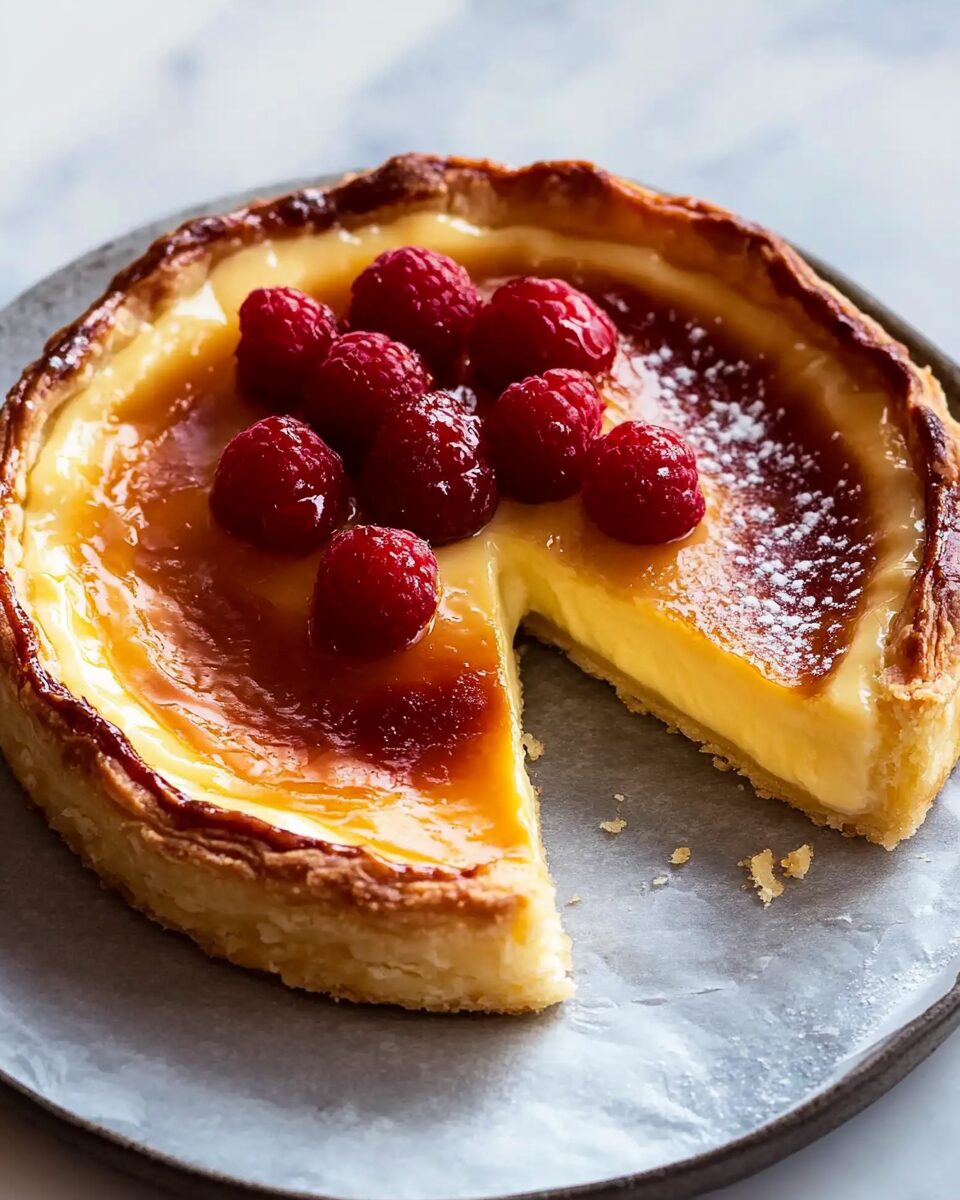This traditional Flan Pâtissier is a showstopper straight from the heart of French patisseries. With its thick, silky vanilla custard filling and crisp, buttery puff pastry shell, it’s the dessert equivalent of a warm hug – elegant, comforting, and indulgent. The bronzed top adds a caramelized finish that’s not just beautiful, but packed with flavor.
Perfect for any gathering or just an indulgent treat at home, this custard tart is worth every step. Whether you’re an experienced baker or tackling your first French recipe, the payoff is a pastry that will transport you to a quaint café in Paris with every bite. Serve it chilled and let your guests swoon over its creamy perfection and flaky crust.
Full Recipe:
For the Custard (Crème Pâtissière):
-
1 litre (1 quart) full-fat milk
-
2 vanilla beans (or 2 tsp vanilla bean paste)
-
1 cup caster sugar, divided
-
120g egg yolks (approx. 6–7 yolks)
-
1 whole egg
-
70g (7 tbsp) cornflour/cornstarch
-
50g unsalted butter, cubed
For the Pastry:
-
2 sheets frozen butter puff pastry (25cm squares)
-
1 egg yolk, whisked (for brushing)
-
Butter (for greasing the pan)
Directions:
-
Infuse the Milk: Heat milk, half the sugar, and vanilla seeds (and pods) in a saucepan. Bring just to a boil, then cover and let steep for 10 minutes.
-
Make the Yolk Mixture: In a bowl, whisk egg yolks, whole egg, and remaining sugar. Add cornflour and whisk until smooth.
-
Temper the Mixture: Slowly add half the warm milk into the egg mixture, whisking constantly. Then pour it all back into the saucepan.
-
Cook the Custard: Stir over medium-low heat until thickened and lazy bubbles appear. Continue whisking for 20 seconds more.
-
Add Butter & Strain: Whisk in butter, strain through a fine mesh sieve into a bowl, and cover the surface with cling wrap. Cool at room temperature for 3 hours, then chill overnight.
-
Prepare the Pastry Shell: Grease a 20cm springform pan (no base). Line with baking paper. Cut pastry for base and 3 strips for the sides. Assemble while pastry is still mostly frozen.
-
Blind Bake: Freeze assembled shell for 4 hours. Preheat oven to 220°C (430°F). Fill shell with baking paper and beads. Bake for 25 min. Remove beads, bake 5 min more. Cool for 10 min.
-
Assemble the Tart: Lower oven to 200°C (390°F). Whisk custard to loosen, then pour into shell (leave 1cm gap). Smooth top, brush gently with egg yolk.
-
Bake: Bake 65 minutes, turning pan at 45 min. Custard will puff and brown. It’s done even if wobbly in center.
-
Cool & Chill: Let cool at room temp for 4–5 hours. Then refrigerate 6+ hours before serving.
Prep Time: 30 minutes | Cooking Time: 1 hour 10 minutes | Total Time: 1 hour 40 minutes (plus chilling)
Kcal: 335 kcal | Servings: 10 slices
Introduction to Flan Pâtissier
Flan Pâtissier, also known as Parisian Flan, is a classic French dessert that embodies the refined elegance of French patisserie. Often found in every corner bakery across France, it’s a beloved staple among locals, yet remains a culinary discovery for many outside of Europe. This dessert stands out not for being complex or flashy, but for the sheer beauty in its simplicity—thick, silky vanilla custard encased in a flaky, buttery pastry shell, baked until gloriously golden.
Unlike many custard tarts that are delicate or overly sweet, Flan Pâtissier is robust, rich, and restrained. It features crème pâtissière—a type of thickened vanilla custard—firm enough to slice neatly, yet soft enough to melt on your tongue. The result is a bakery-style tart that feels indulgent yet refreshingly refined.
A Cultural Staple in France
To the French, Flan Pâtissier is as common and familiar as a croissant or baguette. It’s the type of treat one might pick up on a whim at the local boulangerie to enjoy as a mid-afternoon snack or dessert after a casual family dinner. What’s fascinating is that despite its humble presentation and everyday availability, it’s deeply respected and held dear by many. It speaks volumes about the French philosophy of food: celebrating flavor and texture without excessive embellishments.
Although it’s ubiquitous in France, this tart is rarely seen in many other parts of the world, particularly in Australia and the United States. This has helped Flan Pâtissier gain almost a cult-like status among pastry enthusiasts and French cuisine aficionados seeking authentic European dessert experiences.
Crème Pâtissière: The Heart of the Tart
The custard at the core of Flan Pâtissier is known as crème pâtissière—a fundamental component in French pastry making. It’s used in everything from éclairs to mille-feuille, and in this tart, it gets the spotlight all to itself. Made from egg yolks, sugar, milk, vanilla, and cornflour (not flour), crème pâtissière for baking needs to be slightly thicker than the version used in other desserts.
One of the secrets to its unforgettable texture is the careful balance between the richness of yolks and the structural support provided by cornstarch. The custard must be whisked and cooked meticulously until it thickens into a glossy, spoon-coating cream. Once set inside the crust, it maintains its shape beautifully when sliced but still offers a melt-in-your-mouth experience.
Puff Pastry vs. Other Crusts
Traditionally, French bakers use various types of pastry for Flan Pâtissier, including pâte sucrée (a sweet tart crust), shortcrust, and puff pastry. Each has its merits, but puff pastry offers a dramatic contrast: light, flaky, and buttery layers that shatter delicately with each bite. This interplay between the rich custard and crisp pastry is what elevates this tart from ordinary to extraordinary.
The crust is blind-baked to ensure it stays firm and doesn’t turn soggy once the custard is added. A key trick used by professionals is baking the tart without the base of the springform pan—directly on a tray—to guarantee the underside remains golden and crisp.
The Beauty of Rustic Presentation
One of the most charming aspects of Flan Pâtissier is its rustic appearance. Unlike precision-manicured tarts found in high-end patisseries, this dessert embraces a more homey, organic look. The edges of the puff pastry may rise unevenly, the surface may blister and bronze in unexpected places, and the top might develop cracks as it cools—and that’s perfectly okay.
In fact, the visual imperfections add to its appeal, giving it the look of an artisan treat made with care and character. It’s a visual departure from the hyper-polished desserts seen on Instagram, but it aligns with the soul of traditional baking: flavor and texture above aesthetics.
Serving and Storage Tips
Flan Pâtissier is best served chilled, after a minimum of six hours in the fridge to allow the custard to fully set. Ideally, it should rest overnight to develop deeper vanilla notes and ensure clean slicing. When ready to serve, remove it from the refrigerator about an hour ahead of time to bring it to room temperature for optimal texture and flavor.
The tart keeps well for four to five days in the fridge, though the puff pastry will gradually lose some of its crispness. That said, most people will still find it delightful, even on day four. The custard remains luscious, and any softening of the pastry doesn’t detract from the overall experience.
Baker’s Tips and Tricks
Although Flan Pâtissier may appear intimidating due to its multiple steps and chilling times, it’s actually quite manageable when broken down. Here are some tips to ensure success:
-
Use butter puff pastry: Avoid cheaper margarine-based versions. Butter not only tastes better but creates better layers and flake.
-
Weigh ingredients precisely: Especially the egg yolks and cornstarch. These two determine how well the custard sets.
-
Whisk constantly while cooking: This prevents lumps and ensures a smooth, thick custard.
-
Let the custard cool before filling the shell: Pouring hot custard into the pastry will compromise the texture of the crust.
-
Don’t panic if it jiggles: When baked, the tart will still wobble slightly. It sets during refrigeration, not in the oven.
-
Use vanilla beans if possible: The flecks of real vanilla seeds enhance both flavor and visual appeal.
What Makes Flan Pâtissier Unique
So many custard-based desserts exist, from Portuguese pastéis de nata to American custard pies. What sets Flan Pâtissier apart is its balance. It’s not overly sweet, allowing the vanilla to shine. The texture is thick but supple. The pastry is bold yet not overpowering. It’s a dessert that leans into subtlety and harmony rather than overwhelming richness or decorative excess.
It’s also a wonderful blank canvas. While the traditional recipe is a celebration of vanilla, adventurous bakers can experiment with infusions like citrus zest, cardamom, or even espresso. However, purists will argue—often rightly—that it’s perfect just the way it is.
Conclusion
Flan Pâtissier is one of those desserts that quietly earns a spot in your culinary heart. It doesn’t shout with sugar or dazzle with layers of decoration, but what it does, it does flawlessly. A crisp puff pastry crust, thick and creamy custard, and that characteristic golden top combine into a pastry that feels both indulgent and deeply comforting.
Whether you’re recreating a memory from a French vacation or simply exploring European baking at home, this tart is worth every step. It embodies what French desserts do best: honoring simple, high-quality ingredients with technique and respect. Once you taste your first slice, chances are you’ll find yourself making it again—and again.






